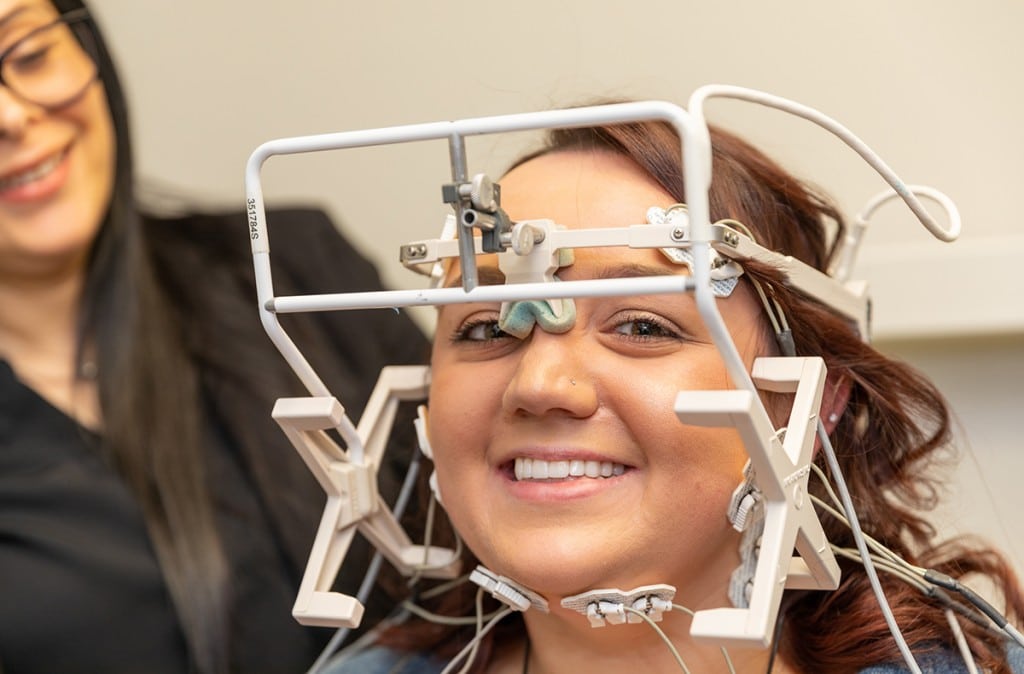Types of TMJ
As we mentioned above, a “TMJ disorder” is something of an umbrella term. There are many different types of the condition, although nobody knows exactly how many there are. Currently, most experts agree on at least these three that are well-defined and described:
- Myofascial pain disorder (MPD)
- Disc displacement (DD)
- Degenerative joint disease (DJD)
- Myofascial pain disorder (MPD)
- Disc displacement (DD)
- Degenerative joint disease (DJD)
MPD is considered the most common form of TMJ disorder. It occurs when tense, overworked jaw muscles cause pain and other symptoms. Notably, ear-related symptoms are common with MPD.
DD occurs when the cushioning disc in the temporomandibular joint slides out of place. This can lead to jaw popping and clicking, as well as irregular jaw motion. It can cause restriction in your jaw movement. Left untreated, this can lead to locked jaw as well as excessive damage to the jaw joint.
DJD occurs when the jaw joint breaks down, usually because of some type of arthritis. The most common form of arthritis responsible for jaw joint damage is osteoarthritis, accelerated joint wear and damage that occurs with age. However, rheumatoid arthritis can also attack your jaw joint, leading to extensive jaw joint damage, limited jaw function, and jaw pain.
It’s possible to have all three types of TMJ as well as other types that haven’t been described yet.
Signs and Symptoms of TMJ Disorder
With so many different types of TMJ, it shouldn’t be a surprise that there are also many signs and symptoms of TMJ. This has led some people to describe TMJ as a “great imposter” because its symptoms masquerade as other conditions.
Here are some of the signs and symptoms people report related to their TMJ:
- Headaches and migraines
- Jaw pain
- Popping, clicking, or grinding noise in the jaw
- A feeling that your bite is off or teeth don’t fit together right
- Restricted jaw motion
- Jaw locked open or closed
- Chipped, cracked, or worn teeth
- Toothaches
- Ear fullness and earache
- Ringing in the ears
- Vertigo
- Pain in the face, neck, shoulders, or back
- Numbness or tingling in the fingers and hands
- Headaches and migraines
- Jaw pain
- Popping, clicking, or grinding noise in the jaw
- A feeling that your bite is off or teeth don’t fit together right
- Restricted jaw motion
- Jaw locked open or closed
- Chipped, cracked, or worn teeth
- Toothaches
- Ear fullness and earache
- Ringing in the ears
- Vertigo
- Pain in the face, neck, shoulders, or back
- Numbness or tingling in the fingers and hands
With this diversity of symptoms, it’s no wonder that a doctor or dentist might misdiagnose your condition. For example, many people get a diagnosis of primary tension headache or migraine when their headaches are actually secondary to TMJ.
Almost no one has all the TMJ symptoms, but if you have three or more, it’s time to talk to Westchester, NY TMJ dentist Dr. Mejia today.
TMJ Diagnosis
TMJ diagnosis takes time and careful attention. It’s a necessary foundation for ensuring successful treatment, but many lack the training and equipment to do it thoroughly.
TMJ diagnosis begins by listening to your medical history as well as a description of your symptoms. Westchester TMJ dentist Dr. Mejia might ask for additional information, since many people have symptoms they might not realize are linked to their TMJ.
After listening to your medical history and symptoms, Dr. Mejia might palpate–touch–your jaw muscles and joints. This might be painful, and you should tell Dr. Mejia how much it hurts–this helps her diagnose your condition.
Next, Dr. Mejia might collect additional scientific readings. Using advanced technology like T-Scan and electromyography, Dr. Mejia will get information about muscle tension and bite force. Often, we will then use TENS (transcutaneous electrical nerve stimulation) to relax your jaw muscles so we can get measurements independent of techniques your body uses to adapt to TMJ. This helps us understand your body’s natural, healthy bite.
In some cases, Dr. Mejia might recommend CBCT (cone beam computed tomography). CBCT is an advanced imaging technique that lets us create a highly detailed image of the bones in your temporomandibular joints. The machine is open and uses minimal radiation, so you can avoid claustrophobic reactions and limit your radiation exposure while getting precise information about your condition.
With all this information, Dr. Mejia can diagnose your condition and recommend appropriate treatment.

TMJ Treatment
In the past, TMJ treatment often involved surgery. The surgery didn’t give great results and had a high rate of complications. Today, we consider TMJ surgery a treatment of last resort.
Instead, Westchester County TMJ dentist Dr. Mejia emphasizes nonsurgical TMJ treatments. This includes:
- Exercises and stretches
- Muscle relaxants
- TENS
- Bite splints (orthotics)
- Dental restorations
- Exercises and stretches
- Muscle relaxants
- TENS
- Bite splints (orthotics)
- Dental restorations
Exercises and stretches can help you resolve minor cases of TMJ disorder, especially of the MPD type. Muscle relaxants can also help with MPD-type TMJ. For a drug-free alternative, regular TENS treatments can sometimes provide relief. For MPD and DD types of TMJ, a bite splint can be very effective at holding your jaw in a healthy position. Once we’ve achieved good results with a bite splint, we can use dental restorations to achieve the same healthy jaw position without the bite splint. This can also help by repairing damage to your smile caused by your TMJ.
Help for TMJ in Westchester County
Do you have multiple TMJ symptoms? Let Westchester County TMJ dentist Dr. Mejia determine whether your symptoms are linked to TMJ or might have an entirely different cause.
Please call (914) 594-6854 or use our online form to request an appointment at Westchester TMJ & Aesthetics in Mohegan Lake.
